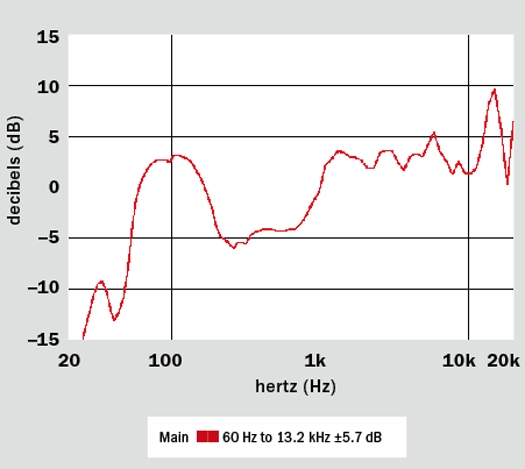Zvox Z-Base 550 TV sound system Page 3
TEST BENCH

Bass limits (lowest frequency and maximum SPL with limit of 10% distortion at 2 meters in a large room) 50 Hz at 92.9 dB 97.4 dB average SPL from 50 Hz to 80 Hz 100.4 dB maximum SPL at 63 Hz B andwidth uniformity: 95% Maximum full-band output: Approximately 94 dB (at 2 meters) The frequency-response graph is weighted to reflect how sound arrives at a listener's ears with normal speaker placement. Measurements were made from the center channel at 2 meters to include full effects of cabinet diffraction and front-panel reflections, and averaged across a 20º listening window. A mono signal was fed to both channels, the PhaseCue control was turned down all the way, and the subwoofer and treble controls were left at their factory settings. Response of the woofer and port was measured with a microphone positioned about 1 inch away. The combination of these bass-response measurements was then scaled and spliced to the quasi-anechoic response.
These measurements apply only to the center channel. Because of the crosstalk cancellation filtering used in the left and right channels, there's no point in measuring them, as their response has been intentionally altered to fool the ear into thinking it's hearing surround sound.
The ±5.7 dB response from 60 Hz to 13.2 kHz isn't terribly smooth taken on its own. There's an obvious gap in the response between the woofer/port and the 2-inch drivers. The gap, which falls roughly between 180 Hz and 1 kHz, is the reason that voices can sound subjectively thin through the Z-Base 550. There's also a sharp peak of about 10.1 dB centered at 15 kHz. However, response is fairly smooth through the middle to upper vocal range ; the range between 1 kHz and 13 kHz seems to fall in the "sweet spot" of the 2-inch drivers. Off-axis response is surprisingly smooth for a triple-driver arrangement, the only significant error being a peak at 6 kHz that appears at angles of 20º and greater. The treble control alters the response significantly at frequencies of about 2 kHz and higher; its response is ±6 dB at frequency of 9 kHz and higher.
The woofer's response is pretty good for its size, probably because of the Z-Base 550's ample internal space. It delivers usable bass response down to 50 Hz, where it hits 92.9 dB at 2 meters with 10% distortion; at our next measurement point, 45 Hz, the response at 10% distortion drops by 11.3 dB. Maximum output is 100.4 dB at 63 Hz, more than enough to fill out the Z-Base 550's sound. At such high output levels, some extraneous noise - likely rattles from the cabinet and grille - intrudes, but I never experienced these problems during normal listening.
Although almost all of the home theater speakers and electronics reviewed in Sound & Vision can deliver satisfying volume in a typical living room, that's not a safe assumption with a device like the Z-Base 550. I decided to measure its overall output to get a realistic idea of what it can do in a typical bedroom. I played various types of music, turned up the level to the point where I could hear distortion, then backed the volume down a touch. I then measured the peak output using an SPL meter with peak hold. At 2 meters, results ranged from 90 dB to 94 dB, depending on the recording. Most conventional home theater gear can play at least 10 dB louder, but the Z-Base 550's output is adequate for light entertainment in small to medium-size rooms.













































